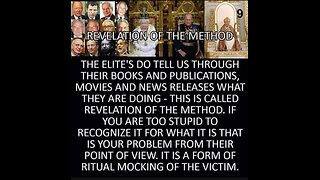Premium Only Content

Beyond the Veil: Navigating Hyper-Awareness in a World of Illusions
Introduction: The Weight of Seeing Too Much
To be “too aware” is both a gift and a burden. It’s the ability to see beyond the surface, to question the fabric of reality, and to recognize the constructed nature of the world around us. But with this heightened awareness comes a profound sense of alienation—realizing that so much of what governs human life is arbitrary, fabricated, or rooted in subconscious programming. For those who feel like they’re “seeing through the matrix,” the challenge lies in finding meaning and grounding in a world that often feels meaningless and contrived.
This article dives into the layers of hyper-awareness, exploring its psychological, philosophical, and even metaphysical dimensions. We’ll uncover how this perspective can be both a curse and a path to enlightenment, offering insights into how to navigate life when the illusion becomes too obvious.
1. The Nature of Constructs: Why Everything Feels “Made Up”
1. The Human-Made Reality
• The world as we know it is indeed constructed. From the names of the days of the week to the concept of money, human beings have created systems, symbols, and meanings to impose order on chaos.
• These constructs serve as tools for survival, cooperation, and progress. Yet, when viewed from a detached perspective, they can feel absurd—an elaborate game we’ve collectively agreed to play.
2. The Subconscious Programming
• Much of our perception and behavior is governed by subconscious programming—beliefs, values, and norms absorbed from family, culture, and society.
• Recognizing this programming can be disorienting, as it reveals how much of our “reality” is inherited rather than inherently true.
3. The Illusion of Permanence
• Hyper-awareness often brings the realization that everything is transient. Names, systems, and even civilizations come and go. This impermanence can feel liberating but also unsettling, as it challenges the sense of stability we crave.
2. The Matrix Analogy: Seeing Through the Layers
1. The Constructed World
• The “Matrix” is a useful metaphor for understanding the layers of illusion in our reality. Like the characters in the film, many people go through life unaware of the deeper systems at play, content to follow the rules of the game.
• To “see through the matrix” is to become conscious of these layers, recognizing them as constructs rather than intrinsic truths.
2. The Burden of Awareness
• Hyper-awareness can feel isolating. Once you see the strings pulling the puppet show, it’s hard to unsee them. Activities that once seemed meaningful—career achievements, social status, or material possessions—can lose their appeal.
• This detachment can lead to existential angst, as the question arises: “If it’s all made up, what’s the point?”
3. The Psychological Perspective: Navigating Hyper-Awareness
1. Cognitive Dissonance and Existential Angst
• The clash between what society tells us is important and what hyper-awareness reveals creates cognitive dissonance. This often manifests as frustration, apathy, or even despair.
2. The Role of Mindfulness
• Practicing mindfulness can help anchor hyper-aware individuals. Instead of spiraling into the meaninglessness of constructs, mindfulness encourages presence in the here and now.
• For example, while a road sign may be arbitrary, the act of walking a path and experiencing the journey can hold intrinsic value.
3. Creative Expression
• Many hyper-aware individuals find solace in creativity. Writing, art, music, or philosophy become outlets for exploring and articulating their perspective on the world.
4. The Philosophical Dimension: Finding Meaning in the Void
1. Absurdism: Embracing the Ridiculousness
• The philosophy of absurdism, as articulated by Albert Camus, suggests that life’s lack of inherent meaning isn’t a problem—it’s an opportunity.
• By accepting the absurdity of existence, we free ourselves to create our own meaning, reveling in the experience of being alive.
2. Eastern Philosophy and Detachment
• Many Eastern traditions, such as Buddhism and Taoism, resonate with the hyper-aware perspective. They teach that much of what we cling to is illusion (maya) and that liberation comes from recognizing this truth.
• Practices like meditation and self-inquiry can help individuals navigate their awareness without becoming overwhelmed by it.
3. The Role of Play
• From a philosophical perspective, if life is a game, why not play it? Recognizing the arbitrary nature of constructs doesn’t mean rejecting them entirely. Instead, it can mean engaging with them consciously, with a sense of curiosity and playfulness.
5. The Metaphysical Perspective: Hidden Knowledge and Awareness
1. The Role of Consciousness
• Some metaphysical traditions view hyper-awareness as a sign of spiritual awakening. To see through the illusion is to begin accessing deeper layers of consciousness, moving beyond the physical and into the realms of energy, intention, and interconnectedness.
2. The Purpose of Awareness
• Hyper-awareness may not be a burden but a calling. By understanding the constructs of reality, individuals can become creators within the matrix, shaping new systems, ideas, and ways of being.
3. The Collective Evolution
• Many believe that humanity is collectively moving toward greater awareness. As more individuals “see through the matrix,” they contribute to a shift in consciousness that challenges outdated systems and paves the way for a more authentic and connected existence.
6. Practical Advice: Living with Hyper-Awareness
1. Accept What You See
• Resistance to the illusion can create unnecessary suffering. Accepting that constructs exist while choosing how to engage with them is a healthier approach.
2. Seek Connection
• While hyper-awareness can feel isolating, finding like-minded individuals who share your perspective can provide comfort and inspiration.
3. Focus on Experiences
• Instead of obsessing over what is “real” or “made up,” focus on the experiences that bring joy, growth, or peace. Whether it’s relationships, nature, or creative pursuits, these moments hold intrinsic value.
4. Contribute to Change
• Use your awareness to question harmful systems and contribute to creating better ones. Whether through activism, education, or innovation, your perspective can be a catalyst for positive transformation.
Conclusion: The Gift of Hyper-Awareness
To be “too aware” is to stand at the edge of illusion and truth, holding the power to see through constructs while still engaging with the human experience. This perspective, while challenging, offers profound opportunities for growth, creativity, and impact.
By balancing detachment with engagement, hyper-aware individuals can navigate the world with wisdom and purpose. The key lies in embracing both the absurdity and the beauty of existence, recognizing that while much of life may be “made up,” the journey itself is undeniably real—and worth experiencing fully.
-
 5:43
5:43
FragmentsOfTruth
2 days agoThe 1968 Broadcast That Exposed the Entire Playbook
245 -
 44:40
44:40
Katie Miller Pod
4 hours ago $2.88 earnedEpisode 1 - Vice President JD Vance | The Katie Miller Podcast
29.6K11 -
 13:09:34
13:09:34
LFA TV
1 day agoLFA TV ALL DAY STREAM - MONDAY 8/11/25
190K20 -
 1:44:36
1:44:36
RiftTV
6 hours agoBREAKING: Trump FEDERALIZES D.C. To RESTORE Law & Order | The Rift | Ryan Matta, Olivia Krolczyk + Braeden Sorbo
36.6K13 -

megimu32
4 hours agoOTS: Breakfast Nostalgia + Blind Chocolate Cereal Showdown… LIVE! 🍫🥣
28K2 -
 LIVE
LIVE
LIVE WITH CHRIS'WORLD
11 hours agoLIVE WITH CHRIS’WORLD - It’s Called LAW & ORDER
93 watching -
 11:07
11:07
AlaskanBallistics
1 day ago $1.02 earnedBreek-Lok Quick Detach Hub Mount and Flash Hider System Review
21.5K5 -
 57:44
57:44
Donald Trump Jr.
8 hours agoExclusive Interview with Deputy Secretary of State Chris Landau | Triggered Ep266
108K54 -
 58:40
58:40
BonginoReport
12 hours agoModern Dating Woes & How To Resist Temptation w/ Tilly Dillehay - Hayley Caronia (Ep.109)
43.7K20 -
 53:55
53:55
The Quiet Part
11 hours agoThey Want You to Sign Over Your Life Insurance—So They Can Keep Lying to You
17.9K10